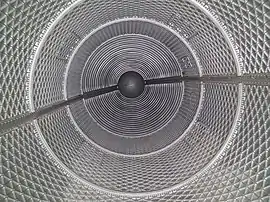PSLV-C5
PSLV-C5 was the fifth operational launch and overall eighth mission of the Polar Satellite Launch Vehicle program. This launch was also the fifty-second launch by the Indian Space Research Organisation (IRSO) since its first mission on 1 January 1962. The vehicle carried and injected India's remote sensing satellite Resourcesat-1 (also known as IRS-P6) into a sun-synchronous orbit; this was the heaviest and most sophisticated satellite built by IRSO through 2003. PSLV-C5 was launched at 04:52 hours Coordinated Universal Time (10:22 hours Indian Standard Time) on 17 October 2003 from Satish Dhawan Space Centre.[1][2][3][4][5][6][7]
 Model of the PSLV rocket | |
| Names | Cartosat-1 mission |
|---|---|
| Mission type | Deployment of Resourcesat-1 satellite. |
| Operator | ISRO |
| Website | ISRO website |
| Mission duration | 1,084 seconds |
| Spacecraft properties | |
| Spacecraft | Polar Satellite Launch Vehicle |
| Spacecraft type | Expendable launch vehicle |
| Manufacturer | ISRO |
| Launch mass | 295,930 kilograms (652,410 lb) |
| Payload mass | 1,360 kilograms (3,000 lb) |
| Dimensions | 44.4 metres (146 ft) (overall height) |
| Start of mission | |
| Launch date | 04:52:00, October 17, 2003 (UTC) (UTC) |
| Rocket | Polar Satellite Launch Vehicle |
| Launch site | Satish Dhawan Space Centre |
| Contractor | ISRO |
| End of mission | |
| Deactivated | October 17, 2003 |
| Orbital parameters | |
| Reference system | Sun-synchronous orbit |
| Payload | |
| Resourcesat-1 (also known as IRS-P6) | |
| Mass | 1,360 kilograms (3,000 lb) |
Mission highlights
PSLV-C5 was the fifth operational and overall eighth mission of the PSLV program. The vehicle carried and injected the heaviest and most sophisticated remote sensing satellite built by the ISRO through 2003, Resourcesat-1 (also known as IRS-P6).[1][2][4][8]
Mission parameters
- Mass:
- Total liftoff weight: 295,930 kilograms (652,410 lb)
- Payload weight: 1,360 kilograms (3,000 lb)
- Overall height: 44.4 metres (145.7 ft)
- Propellant:
- First stage: Solid HTPB based (138.0 + 6 x 9 tonnes)
- Second stage: Liquid UH 25 + N
2O
4 (41.5 tonnes) - Third stage: Solid HTPB based (7.6 tonnes)
- Fourth stage: Liquid MMH + MON (2.5 tonnes)
- Engine:
- First stage: Core (PS 1) + 6 strap-on Propellant strap on motors (PSOM)
- Second stage: Vikas
- Third stage: PS 3
- Fourth stage: PS 4
- Thrust:
- Altitude: 827 kilometres (514 mi)
- Maximum velocity:7,440 metres per second (24,409 ft/s) (recorded at time of IRS-P6 separation)
- Duration: 1,084 seconds
Payload
PSLV-C5 carried and deployed the ISRO's Resourcesat-1 (a.k.a. IRS-P6) into a sun-synchronous orbit. Resourcesat-1, which carried three cameras ("High Resolution Linear Imaging Self-Scanner", "Medium Resolution Linear Imaging Self-Scanner" and "Advanced Wide Field Sensor") was the tenth ISRO satellite in the IRS series and was intended not only to continue the remote sensing data services provided by IRS-1C and IRS-1D, but also to enhance the data quality. Although IRS-P6 had a design life of five years, the satellite was still operational as of October 2015.[1][2][9][10][11]
| Country | Name | Nos | Mass | Type | Objective |
|---|---|---|---|---|---|
| IRS-P6 | 1 | 1,360 kg | Satellite | Earth observation | |
Launch and planned flight profile

PSLV-C5 was launched at 04:52 hours Coordinated Universal Time (10:22 hours Indian Standard Time) on 17 October 2003 from Satish Dhawan Space Centre. The mission was planned with pre-flight prediction of covering overall altitude of 827 kilometres (514 mi). The flight profile was as follows:[2]
| Stage | Time (seconds) | Altitude (kilometre) | Velocity (metres/sec) | Event | Remarks |
|---|---|---|---|---|---|
| First stage | T+0 | 0.02 | 452 | Ignition of PS 1 | Lift off |
| T+1.2 | 0.02 | 452 | Ignition of 4 ground-lit PSOM | ||
| T+25 | 2.348 | 543 | Ignition of 2 air-lit PSOM | ||
| T+68 | 23.230 | 1,156 | Separation of 4 ground-lit PSOM | ||
| T+90 | 41.844 | 1,609 | Separation of 2 air-lit PSOM | ||
| T+113.01 | 67.353 | 1,991 | Separation of PS 1 | ||
| Second stage | T+113.21 | 67.578 | 1,990 | Ignition of PS 2 | |
| T+157.01 | 115.706 | 2,316 | Separation of heat shield | ||
| T+265.73 | 244.864 | 4,153 | Separation of PS 2 | ||
| Third stage | T+266.93 | 246.531 | 4,149 | Ignition of HPS 3 | |
| T+522.85 | 591.593 | 5,854 | Separation of HPS 3 | ||
| Fourth stage | T+556.5 | 626.557 | 6,768 | Ignition of PS 4 | |
| T+1,017.0 | 826.388 | 7,426 | Cut-off of PS 4 | ||
| T+1,084.0 | 827.032 | 7,440 | Resourcesat-1 separation | Mission complete | |
References
- "PSLV-C5". Indian Space Research Organisation. Retrieved 26 August 2016.
- "PSLV-C5 brochure" (PDF). Indian Space Research Organisation. Retrieved 26 August 2016.
- "ISRO Timeline". Indian Space Research Organisation. Retrieved 26 August 2016.
- "PSLV-C5 launched successfully". The Economic Times. Retrieved 26 August 2016.
- "Countdown starts for PSLV-C5's launch". The Times of India. Retrieved 26 Aug 2016.
- "PSLV". spacelaunchreport.com. Retrieved 26 August 2016.
- "IRS-P6". NASA. Retrieved 26 August 2016.
- "India launches PSLV-C5 rocket successfully". The Indian Express. Retrieved 6 October 2016.
- "Resourcesat-1 (IRS-P6)" (PDF). United States Geological Survey. Archived from the original (PDF) on 9 December 2016. Retrieved 26 August 2016.
- "Shrimp farms kept away". The Times of India. Retrieved 6 October 2016.
- "Brazilian earth station to get data from Indian satellites". The Times of India. Archived from the original on 20 May 2017. Retrieved 6 October 2016.
